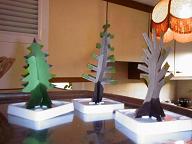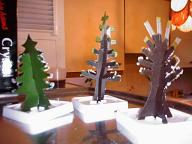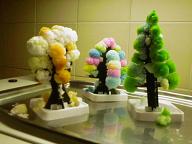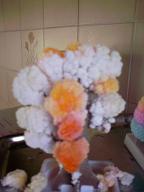










The word crystal comes from the Greek word Krystallos or Kryos, meaning ice cold. The experiments here are designed to produce colourful trees whose foliage is made of crystals.
The base of each cardboard tree is placed in a saturated solution of a salt. The solution penetrates the cardboard by capillary action and evaporates to produce crystals. The crystals nucleate first at the edges of the cardboard, and then grow over a period of 24 hours. The colours come from dyes on the original cardboard skeletons.
The materials for the experiments illustrated above were provided by Yaan de Carlan (John Adams action science set).
The following experiment was conducted by Gregory Vogt, gregoryvogt@earthlink.net, in an attempt to recreate the crystalline trees using readily available ingredients. The actual chemical recipe was obtained from the International Union of Crystallography web article dealing with crystal growth. Appropriate safety precautions must be observed whenever using chemicals.
The tree skeletons were made using the cardboard backing from a notebook tablet. The tree was placed in a shallow aluminum dish that had the following materials:
The results are illustrated below.
|
|
|
| PT Group Home | Materials Algorithms |